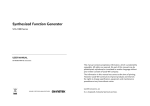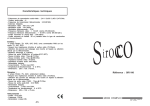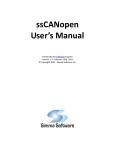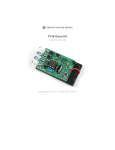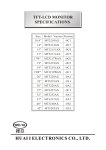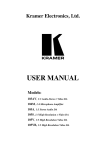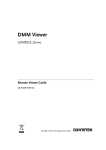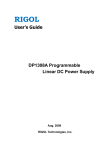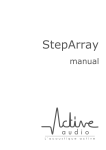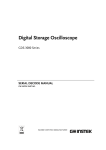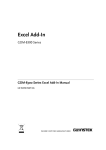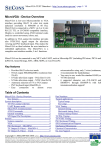Download User Manual
Transcript
This manual contains proprietary information, which is protected by copyrights. All rights are reserved. No part of this manual may be photocopied, reproduced or translated to another language without prior written consent of Good Will company. The information in this manual was correct at the time of printing. However, Good Will continues to improve products and reserves the rights to change specification, equipment, and maintenance procedures at any time without notice. Good Will Instrument Co., Ltd. No. 7-1, Jhongsing Rd., Tucheng City, Taipei County 236, Taiwan. Table of Contents Table of Contents SAFETY INSTRUCTIONS ....................................................5 Safety Symbols ....................................................... 5 Safety Guidelines ................................................... 5 GETTING STARTED ............................................................8 Technical background ............................................. 9 Lineup/Features ....................................................11 Front Panel ...........................................................12 Rear Panel.............................................................15 Set Up...................................................................16 Operation Shortcuts ..............................................18 SINE/SQUARE/TRIANGLE WAVE .....................................19 Activate waveform .................................................20 Set Frequency........................................................20 Set Amplitude .......................................................22 Set Duty Cycle (Square Waveform).........................23 Set Offset..............................................................23 TTL OUTPUT ....................................................................25 Activate TTL ..........................................................25 Set Frequency........................................................26 Set Duty Cycle .......................................................27 APPLICATION EXAMPLES ................................................28 Reference Signal for PLL System ............................28 Trouble-Shooting Signal Source .............................28 Transistor DC Bias Characteristics Test..................29 Amplifier Over-Load Characteristic Test .................30 Amplifier Transient Characteristics Test .................30 3 SFG-1000 Series User Manual Logic Circuit Test .................................................. 32 Impedance Matching Network Test ....................... 32 Speaker Driver Test............................................... 33 FAQ ................................................................................. 34 APPENDIX ....................................................................... 35 Fuse Replacement ................................................ 35 Specification ........................................................ 37 Declaration of Conformity..................................... 39 INDEX ............................................................................. 40 4 Safety Instructions SAFETY INSTRUCTIONS This chapter contains important safety instructions that you must follow when operating SFG-1000 series and when keeping it in storage. Read the following before any operation to insure your safety and to keep the best condition for SFG-1000 series. Safety Symbols These safety symbols may appear in this manual or on SFG-1000 series. WARNING CAUTION Warning: Identifies conditions or practices that could result in injury or loss of life. Caution: Identifies conditions or practices that could result in damage to SFG-1000 series or to other properties. Attention Refer to the Manual Earth (ground) Terminal Safety Guidelines General Guideline • • CAUTION • • • • • Do not place any heavy object on SFG-1000 series. Avoid severe impacts or handling that leads to damage. Do not discharge static electricity to SFG-1000 series. Use only mating connectors, for the terminals. Do not block or obstruct cooling vent opening. Do not perform measurements at power source and building installation site (Note below). Do not disassemble SFG-1000 series unless you are qualified as service personnel. 5 Safety Instructions • • • Storage Environment • • • Pollution degree 1: No pollution or only dry, non-conductive pollution occurs. The pollution has no influence. Pollution degree 2: Normally only non-conductive pollution occurs. Occasionally, however, a temporary conductivity caused by condensation must be expected. Pollution degree 3: Conductive pollution occurs, or dry, non-conductive pollution occurs which becomes conductive due to condensation which is expected. In such conditions, equipment is normally protected against exposure to direct sunlight, precipitation, and full wind pressure, but neither temperature nor humidity is controlled. Location: Indoor Relative Humidity: < 70% Temperature: −10°C to 70°C Power cord for the United Kingdom When using SFG-1000 series in the United Kingdom, make sure the power cord meets the following safety instructions. NOTE: This lead / appliance must only be wired by competent persons WARNING: THIS APPLIANCE MUST BE EARTHED IMPORTANT: The wires in this lead are coloured in accordance with the following code: Green/ Yellow: Earth Blue: Neutral Brown: Live (Phase) As the colours of the wires in main leads may not correspond with the colours marking identified in your plug/appliance, proceed as follows: The wire which is coloured Green & Yellow must be connected to the Earth terminal marked with the letter E or by the earth symbol or coloured Green or Green & Yellow. The wire which is coloured Blue must be connected to the terminal which is marked with the letter N or coloured Blue or Black. The wire which is coloured Brown must be connected to the terminal marked with the letter L or P or coloured Brown or Red. If in doubt, consult the instructions provided with the equipment or contact the supplier. This cable/appliance should be protected by a suitably rated and approved HBC mains fuse: refer to the rating information on the equipment and/or user instructions for details. As a guide, cable of 0.75mm2 should be protected by a 3A or 5A fuse. Larger conductors would normally require 13A types, depending on the connection method used. Any moulded mains connector that requires removal /replacement must be destroyed by removal of any fuse & fuse carrier and disposed of immediately, as a plug with bared wires is hazardous if a engaged in live socket. Any re-wiring must be carried out in accordance with the information detailed on this label. 7 SFG-1000 Series User Manual GETTING STARTED This chapter describes SFG-1000 series in a nutshell, including main features and front/rear/display introduction. Follow the Set Up section to properly install and power up SFG-1000 series. Technical background .............................................9 SFG-1000 series overview Series lineup ........................................................ 11 Main features ....................................................... 11 Panel introduction Main Display ........................................................ 12 Entry keys ............................................................. 13 Others.................................................................. 14 Rear Panel ............................................................ 15 Setup Tilt stand.............................................................. 16 Power up .............................................................. 17 Functionality check ............................................... 17 Quick reference 8 Operation Shortcuts ............................................. 18 Getting Started Technical background Traditional function generators SFG-1000 series uses the latest Direct Digital Synthesis (DDS) technology to generate stable, high resolution output frequency. The DDS technology solves several problems encountered in traditional function generators, as follows. Constant current circuit methodology This analog function generating method uses a constant current source circuit built with discrete components such as capacitors and resistors. Temperature change inside the generator greatly affects the components characteristics which lead to output frequency change. The results are poor accuracy and stability. DDS methodology In DDS, the waveform data is contained in and generated from a memory. A clock controls the counter which points to the data address. The memory output is converted into analog signal by a digital to analog converter (DAC) followed by a low pass filter. The resolution is expressed as fs/2k where fs is the frequency and k is the control word, which contains more than 28bits. Because the frequency generation is referred to clock signal, this achieves much higher frequency stability and resolution than the traditional function generators. 9 SFG-1000 Series User Manual Block diagram DDS synthesizer consists of Phase accumulator (counter), lookout table data (ROM), Digital-to-analog converter (DAC), and Low-pass filter (LPF). Frequency Control Word (K) 28bit 28bit Phase Accumulator 28bit System Clock (fs) Register Table ROM/RAM 12bit Digital-Analog Converter Low-Pass Filter Output (fo) The phase accumulator adds the frequency control word K at every clock cycle fs. The accumulator output points to a location in the Table ROM/RAM. The DAC converts the digital data into an analog waveform. The LPF filters out the clock frequency to provide a pure waveform. 10 Getting Started Lineup/Features Series lineup Features Frequency Offset TTL output −40dB attn. Voltage display 3MHz 3MHz ● ● ● ● ● ● ― ● Lineup SFG-1003 SFG-1013 Main features Performance • • • • Features • • • • • • • • • • Interface • • High resolution using DDS technology High frequency accuracy: ±20ppm Low distortion: −55dBc @ ≤200kHz High resolution 100mHz Digital user interface with 6-digit LED display Various output waveforms: Sine, Square, and Triangle TTL output Amplitude control −40dB attenuation Duty control Variable DC offset control Output On/Off control Voltage display (SFG-1013) Output overload protection Frequency output TTL output 11 SFG-1000 Series User Manual Front Panel Main Display 7 segment LED Shows frequency and voltage. TTL indicator Indicates that the TTL output is enabled. For details, see page25. Waveform indicator Indicates the waveform shape: Sine, Square, and Triangle. Frequency indicator Indicates the output frequency: MHz, kHz, or Hz. Voltage indicator (SFG-1013 only) Indicates Voltage unit: mV, or V. For voltage measurement detail, see page22. −40dB indicator (SFG-1013 only) Indicates −40dB attenuation is activated. For details, see page22. 12 Getting Started Entry keys Waveform key Selects the waveform: sine, square, and triangle. For details, see page20. WAVE Activates TTL output. For details, see page25. TTL activation SHIFT WAVE 1 0 Numerical keys Frequency unit selection Cursor selection 9 −40dB attenuation (SFG-1013 only) , 0 SHIFT ) Moves the cursor (frequency editing point) left or right. For details, see page21. SHIFT 4 Specifies the frequency unit: MHz, kHz, or Hz. 8 SHIFT ( Specifies frequency. or 5 3 Attenuates amplitude by −40dB. For details, see page22. Key operation is for SFG-1013 only. Frequency / Voltage display selection (SFG-1013 only) Switches the display between frequency and voltage. For details, see page22. For SFG-1013 only. Shift key Selects the 2nd function associated to the entry keys. The LED lights when Shift is activated. SHIFT Output On/Off key Turns the output On/Off. The LED lights when the output is On. 13 SFG-1000 Series User Manual Others Increases (right turn) or decreases (left turn) the frequency. Frequency editing knob Main output OUTPUT 50 Ω TTL output OUTPUT Amplitude control AMPL Outputs sine, square, and triangle waveform. BNC, 50Ω output impedance. For details, see page20. Outputs TTL output waveform, BNC terminal. For TTL mode details, see page25. Sets the sine/square/triangle waveform amplitude. Turn left (decrease) or right (increase). -40dB (SFG-1003 only) When pulled out, attenuates the sine / square / triangle waveform amplitude by −40dB. For details, see page22. DC offset control OFFSET ADJ 14 When pulled out, sets the DC offset level for sine/square/triangle waveform. Turn left (decrease) or right (increase). The range is −5V ~ +5V, in 50Ω load. For details, see page23. SFG-1000 Series User Manual Set Up Tilt stand Pull out the handle sideways and rotate it. Place SFG horizontally, Or tilt stand. Place the handle vertically for hand carry. 16 Getting Started Power up 1. Check the voltage level displayed on the label(1) and make sure it is identical to the AC line. Then connect the power cord(2). 2. Push and turn On the main power switch on the front panel. 3. The display shows the default setup: Sine wave, 1kHz Functionality check 1. Connect SFG main output to measurement device such as oscilloscope. 2. Press the output key. The output is activated and the LED turns On. 3. Observe the output waveform: 1kHz, sine wave. 17 SFG-1000 Series User Manual Operation Shortcuts Sine wave 250Hz, −40dB amplitude OUTPUT 50 Ω 三 Triangle wave 8kHz,+2V Offset OUTPUT 50 Ω 1. Press Wave key and select Sine 2. Press 2 + 5 + 0 + Shift + 0(Hz) key 3. (SFG-1003) Press Output key, then pull Amplitude knob 4. (SFG-1013) Press Output key, then press Shift + 3 (−40dB) key 1. Press Wave key and select Triangle 2. Press 8 + Shift + 9(kHz) key 3. Press Output key, then pull Offset knob and Rotate WAVE 2 5 0 SHIFT AMPL 3 SHIFT WAVE 8 SHIFT 9 OFFSET ADJ Square Wave 1MHz, 45% duty OUTPUT 50 Ω 1. Press Wave key and select Square 2. Press 1 + Shift + 8(MHz) key 3. Press Output key, then pull Duty knob and rotate WAVE 1 SHIFT 8 DUTY ADJ TTL Output 10kHz 1. OUTPUT 18 Press Output key 2. Press Shift + Wave (TTL) key 3. Press 1 + 0 + Shift + 9(kHz) key SHIFT 1 WAVE 0 SHIFT 9 0 Sine/Square/Triangle Wave S INE/SQUARE/TRIANGLE WAVE Select waveform Activate waveform ................................................ 20 Set frequency Enter frequency .................................................... 20 Edit frequency ..................................................... 21 Maximum frequency limit error ............................ 21 Minimum frequency limit error............................. 22 Set amplitude Set Amplitude ...................................................... 22 View amplitude (SFG-1013) .................................. 22 Attenuate by −40dB .............................................. 22 Set duty cycle (square wave) Enter duty cycle .................................................... 23 Set offset Activate offset ...................................................... 23 Adjust offset ........................................................ 23 Limitation ............................................................ 24 19 SFG-1000 Series User Manual Activate waveform Sine / Square / Triangle WAVE 1. Press the wave key repeatedly. The corresponding indicator appears on the display. Sine waveform Square waveform Triangle waveform 2. Press the output key. The LED turns On. OUTPUT 50 Ω 3. The waveform comes out from the main terminal. 10Vp-p (50Ω load) 20Vp-p (no load) Set Frequency Enter frequency Enter the waveform frequency using the numerical keys. 1.2MHz 1 2 SHIFT 37kHz 3 7 SHIFT 9 4 5 SHIFT 0 45Hz 20 8 Sine/Square/Triangle Wave Edit frequency SHIFT SHIFT 4 Left cursor key moves the active cursor left. 5 Right cursor key moves the active cursor right. Turn the Frequency knob left to decrease the frequency. Turn the frequency knob right to increase the frequency. Maximum frequency limit error For full error message list, see page37. Sine and square waveform frequency is limited to maximum 3MHz. When the input exceeds it, an error message (Err-1) appears and forces the frequency to 3MHz. Triangle waveform frequency is limited to maximum 1MHz. When the input exceeds it, an error message (Err-2) appears and forces the frequency to 1MHz. 21 SFG-1000 Series User Manual Minimum frequency limit error For full error message list, see page37. The minimum frequency is 0.1Hz. When the frequency input becomes less than 0.1Hz, an error message (Err-4) appears and forces the frequency to 0.1Hz. Set Amplitude Amplitude setting does not apply to TTL output (page25). Set Amplitude View amplitude (SFG-1013) Attenuate by −40dB SFG-1003 AMPL The range is 2mVpp ~ 10Vpp for 50Ω output impedance. SHIFT To view the voltage level (amplitude), press the Shift key and dot (V/F) key. The display shows the voltage level. Repeat this procedure to go back to the frequency level view. Both SFG-1003 and SFG-1013 can attenuate the main output by −40dB, in different method. AMPL -40dB 22 Turn the Amplitude knob right (increase) or left (decrease). Pull out the Amplitude knob. The output amplitude is attenuated by −40dB. Sine/Square/Triangle Wave SFG-1013 3 SHIFT Press the Shift key, then 3 (−40dB). The main output is attenuated by −40dB, and the −40dB display indicator in the display turns On. Set Duty Cycle (Square Waveform) The duty cycle setting is not available in sine/triangle waveform. DUTY Pull out the Duty knob. Turn right (left) to increase (decrease) the duty cycle. The default is set at 50%. Enter duty cycle ADJ Range 25% ~ 75% Set Offset Offset setting does not apply to TTL output (page25). Activate offset Adjust offset SFG can add or delete offset to the sine/square/triangle waveform, thus changing the waveform vertical position. Pull the OFFSET knob to turn On Offset setting. OFFSET Turn the knob right (higher position) or left (lower position). ADJ Range −5V ~ +5V for 50Ω output load 23 SFG-1000 Series User Manual Limitation Note that the output amplitude, including the offset, is still limited to: −5 ~ +5V (50Ω load) −10 ~ +10V (no load) Therefore excessive offset leads to peak clip as below. Positive peak clip (50Ω) Clipped +5V Offset -5V Negative peak clip (50Ω) +5V Offset -5V Clipped 24 TTL Output TTL OUTPUT Activate TTL Activate TTL ......................................................... 25 Set frequency Enter frequency .................................................... 26 Edit frequency ...................................................... 26 Maximum frequency limit error ............................ 27 Minimum frequency limit error............................. 27 Set duty cycle Enter duty cycle .................................................... 27 Activate TTL 1. Press the Output key. The LED turns On. (TTL does not activate unless the output is already On) Select TTL SHIFT OUTPUT WAVE 2. Press the Shift key, then the Wave key. TTL indicator appears on the display. 3. The waveform comes out from the TTL output terminal. Level: ≥3Vp-p 25 SFG-1000 Series User Manual Set Frequency Enter frequency Enter the waveform frequency using the numerical keys. 1.2MHz 1 2 SHIFT 8 37kHz 3 7 SHIFT 9 4 5 SHIFT 0 45Hz Edit frequency SHIFT SHIFT 4 Left cursor key moves the active cursor left. 5 Right cursor key moves the active cursor right. Turn the Frequency knob left to decrease the frequency. Turn the frequency knob right to increase the frequency. 26 TTL Output Maximum frequency limit error For full error message list, see page37. Minimum frequency limit error For full error message list, see page37. TTL frequency is limited to maximum 3MHz. When the input exceeds it, an error message (Err-1) appears and forces the frequency to 3MHz. The minimum frequency is 0.1Hz. When the frequency input becomes less than 0.1Hz, an error message (Err-4) appears and forces the frequency to 0.1 Hz. Set Duty Cycle DUTY Enter duty cycle 1. Pull out the Duty knob. Turn right (left) to increase (decrease) the duty cycle. The default is set at 50%. ADJ 2. Press the Duty knob. The duty cycle is reset to 50%. Range 25% ~ 75% 27 SFG-1000 Series User Manual APPLICATION EXAMPLES Reference Signal for PLL System Description Block diagram The SFG output can be used as a cost-effective reference signal for Phase-Locked-Loop system. Directly connect SFG output to PLL input. SFG series Reference In PLL Output Trouble-Shooting Signal Source Description Block diagram 28 The SFG output can be used as the signal source to test the failed part in a circuit system. Isolate the problematic part from the rest, feed the SFG output as a stimulus, and observe the outcome using an oscilloscope. Application Examples Transistor DC Bias Characteristics Test Description Use SFG-1000 series as the signal source for a transistor. Compare the transistor input/output waveform using the oscilloscope. Adjust the DC voltage source to find out the maximum output without distorting the waveform. Block diagram Oscilloscope display 29 SFG-1000 Series User Manual Amplifier Over-Load Characteristic Test Description Block diagram Use the triangle wave output from SFG-1000 series to check the amplifier output distortion caused by overload. The common sine wave is not the ideal source in this case. Observe the linearity of the triangle waveform using an oscilloscope. SFG series Oscilloscope Triangle wave Load Amplifier Amplifier Transient Characteristics Test Description Block diagram 30 Use the square wave output from SFG-1000 series to check the transient frequency response of an amplifier. The common sine wave is not the ideal source in this case. Observe the waveform using an oscilloscope. Application Examples Test step Transient characteristiclist 1. Apply a triangle waveform to the amplifier first. Adjust the waveform amplitude to make sure there is no clipping. 2. Switch to square waveform and adjust its frequency to the middle of the amplifier pass band, such as 20Hz, 1kHz, and 10kHz. 3. Observe the shape of the amplifier output. The following table shows the possible output distortions and their explanations. • • • • • • • • • • • • • High frequency loss No phase shift Low frequency phase shift Trace thickened by hum-voltage High frequency loss Phase shift Low frequency loss Phase shift Low frequency loss Low frequency phase shift • High frequency loss Low frequency phase shift • Damped oscillation • Note Amplitude reduction at low frequency No phase shift Low frequency boosted (accentuated fundamental) For narrow band amplifier testing, square wave may not be suitable. 31 SFG-1000 Series User Manual Logic Circuit Test Description Use the TTL output from SFG-1000 series to test digital circuits. Observe the timing relation of input/output waveform using an oscilloscope. Block diagram Impedance Matching Network Test Description Use SFG-1000 series for impedance matching network: testing its frequency characteristic and matching the impedance. Block diagram Test step 32 Adjust the potentiometer until V2 becomes the half of V1 (V2=0.5V1). Then the impedance Z of the network becomes identical to the potentiometer. Application Examples Speaker Driver Test Description Use SFG-1000 series for testing the frequency characteristics of audio speakers. Record the volt reading versus the input signal frequency. Oscilloscope (or Voltmeter) Block diagram SFG series Speaker Graph The peak voltage occurs on the resonant frequency of the speaker. Peak of Audio Drive Response Correspondent Response (dB) Frequency (Hz) 33 SFG-1000 Series User Manual FAQ ● I pressed the Power switch on the front panel but nothing happens. ● How can I get out of TTL/−40dB mode? ● The device accuracy does not match the specification. ● What are these error messages? I pressed the Power switch on the front panel but nothing happens. Make sure the AC source voltage is set at the rating ±10%, 50/60Hz. For power up sequence, see page17. Otherwise the internal fuse might be blown out. For fuse replacement procedure, see page35. TTL does not activate (pressed Shift + Wave key) You need to turn On the output first. Press the Output key, then press Shift+Wave. For details, see page25. How can I get out of TTL/−40dB mode? For TTL: press the Shift key, then the wave key. For details, see page25. For −40dB mode, press the Shift key, then 3. For details, see page22. The device accuracy does not match the specification. Make sure the device is powered On for at least 30 minutes, within +18°C~+28°C. This is necessary to stabilize the unit to match the specification. What are these error messages? Several messages appear when trying to set the frequency in irregular ways. Page37 summarizes the messages. If there is still a problem, please contact your local dealer or GWInstek at www.gwinstek.com.tw / [email protected]. 34 Appendix APPENDIX Fuse Replacement 1. Take off the Handle In order to detach the handle from the unit, turn the handle down 90 degrees, then pull it off sideways. 220V z 60H 50/ NING W AR AC VE REMO OCK, NING E D SH OP A VOI FORE TO E B UTS INP 7W 1 2. Take off the Cover VA 21 Take off the two metal holdings from the handle joint. Then take the top screw off from the rear panel. 220V 60H z 50/ N ING W AR AC VE REMO OCK, ENING D SH A VOI FORE OP TO BE INPUTS 21VA 17W 35 Appendix Error Messages Frequency error Err-1 Err-2 Err-4 Sine, square, and TTL wave frequency over range. This message appears when entering sine / square / TTL waveform frequency larger than 3MHz. The frequency is automatically forced to 3MHz. Triangle wave Frequency over range. This message appears when entering triangle waveform frequency larger than 1MHz. The frequency is automatically forced to 1MHz. Frequency over resolution. This message appears when trying to enter frequency less than 0.1Hz. The frequency is automatically forced to 0.1 Hz. Specification • SFG series must be powered for at least 30 minutes within the ambient temperature 18°C~28°C to meet this spec. Output Function Amplitude Range Main Sine, Square, Triangle 10Vpp (50Ω load) ±20% at maximum position Amplitude Accuracy (SFG-1013 only) Impedance 50Ω ± 10% −40dB ± 1dB x1 Attenuator DC Offset < −5V ~ >+5V (50Ω load) 25% ~ 75%, ≤1MHz (Square Wave) Duty Range Display 6 digits LED display Frequency Sine/Square Waveform Range Triangle Waveform Range Resolution Stability Accuracy Aging 0.1Hz ~ 3MHz 0.1Hz ~ 1MHz 0.1Hz maximum ±20ppm ±20ppm ±5ppm/year 37 Appendix Declaration of Conformity We GOOD WILL INSTRUMENT CO., LTD. (1) No.7-1, Jhongsing Rd., Tucheng City, Taipei County, Taiwan (2) No. 69, Lu San Road, Suzhou City (Xin Qu), Jiangsu Sheng, China declare, that the below mentioned product Type of Product: Synthesized Function Generator Model Number: SFG-1003, SFG-1013 are herewith confirmed to comply with the requirements set out in the Council Directive on the Approximation of the Law of Member States relating to Electromagnetic Compatibility (89/336/EEC, 92/31/EEC, 93/68/EEC) and Low Voltage Directive (73/23/EEC, 93/68/EEC). For the evaluation regarding the Electromagnetic Compatibility and Low Voltage Directive, the following standards were applied: ◎ EMC EN 61326-1: Electrical equipment for measurement, control and laboratory use –– EMC requirements (1997 + A1:1998 + A2:2001 + A3:2003) Conducted Emission Electrostatic Discharge Radiated Emission EN 61000-4-2: 1995 + A1:1998 + EN 55011: Class A 1998 + A2:2001 A1:1999 + A2:2002 Current Harmonics Radiated Immunity EN 61000-3-2: 2000 + A2:2005 EN 61000-4-3: 2002 + A1:2002 Voltage Fluctuations Electrical Fast Transients EN 61000-3-3: 1995 + A1:2001 + EN 61000-4-4: 2004 A2:2005 ------------------------Surge Immunity EN 61000-4-5: 1995 + A1:2001 ------------------------Conducted Susceptibility EN 61000-4-6: 1996 + A1:2001 ------------------------Power Frequency Magnetic Field EN 61000-4-8: 1993 + A1:2001 ------------------------Voltage Dip/ Interruption EN 61000-4-11: 2004 ◎ Safety Low Voltage Equipment Directive 73/23/EEC & amended by 93/68/EEC Safety Requirements IEC/EN 61010-1: 2001 39 SFG-1000 Series User Manual INDEX 4 summary ...............................................37 F 40dB attenuation faq ........................................................ 34 FAQ ..........................................................34 step....................................................... 22 feature list..................................................11 A frequency editing sine/square/triangle ..............................20 amplifier application example.................... 30 C caution symbol ............................................ 5 cleaning....................................................... 6 constant current circuit ................................ 9 control knob overview ............................... 14 TTL ......................................................26 frequency faq .............................................34 front panel key overview ............................13 fuse rating.....................................................36 replacement...........................................35 safety instruction .....................................6 D G default display ........................................... 17 digital direct synthesis block diagram ....................................... 10 direct digital synthesis ................................. 9 display contents overview .......................... 12 duty cycle faq ........................................................ 34 ground terminal location .................................................15 symbol ....................................................5 I impedance application example .................32 in/out terminal overview ...........................14 sine/square/triangle ............................. 23 TTL ...................................................... 27 E EN55011................................................... 39 EN61010 declaration of conformity...................... 39 L logic application example...........................32 M model lineup..............................................11 O measurement category ............................ 6 pollution degree ...................................... 6 error message error1.................................................... 21 error2.................................................... 21 error4.................................................... 22 40 offset..........................................................23 example setting......................................18 operation environment safety instruction .....................................6 specification ..........................................38 Appendix operation shortcut ......................................18 P storage environment safety instruction..................................... 7 specification .......................................... 38 peak clip ....................................................24 T PLL example application ...........................28 power supply table of contents .......................................... 3 safety instruction .................................... 6 tilt stand .................................................... 16 power up sequence .....................................17 transistor application example ................... 29 faq .........................................................34 R triangle wave example setting ..................................... 18 selection ................................................ 20 rear panel overview ....................................15 S setup step ...................................................16 sine wave example setting......................................18 selection ................................................20 troubleshooting example............................ 28 TTL activation .............................................. 25 example setting ..................................... 18 U UK power cord............................................ 7 speaker application example.......................33 specification ...............................................37 FAQ ......................................................34 square wave V voltage viewing.......................................... 22 W example setting......................................18 selection ................................................20 warning symbol ........................................... 5 41









































